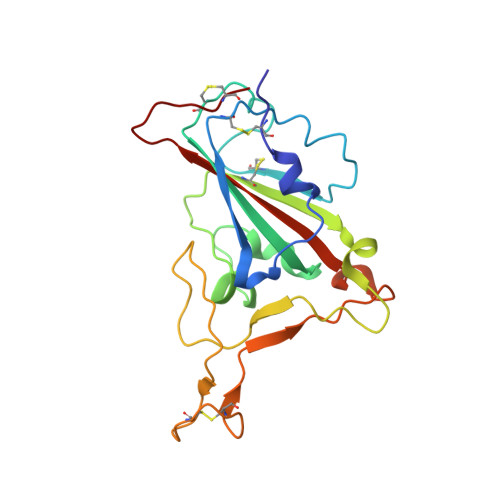Structural basis and analysis of hamster ACE2 binding to different SARS-CoV-2 spike RBDs.
Niu, S., Zhao, Z., Liu, Z., Rong, X., Chai, Y., Bai, B., Han, P., Shang, G., Ren, J., Wang, Y., Zhao, X., Liu, K., Tian, W.X., Wang, Q., Gao, G.F.(2024) J Virol 98: e0115723-e0115723
- PubMed: 38305152
- DOI: https://doi.org/10.1128/jvi.01157-23
- Primary Citation of Related Structures:
8KA8, 8KC2 - PubMed Abstract:
Pet golden hamsters were first identified being infected with the severe acute respiratory syndrome coronavirus 2 (SARS-CoV-2) delta variant of concern (VOC) and transmitted the virus back to humans in Hong Kong in January 2022. Here, we studied the binding of two hamster (golden hamster and Chinese hamster) angiotensin-converting enzyme 2 (ACE2) proteins to the spike protein receptor-binding domains (RBDs) of SARS-CoV-2 prototype and eight variants, including alpha, beta, gamma, delta, and four omicron sub-variants (BA.1, BA.2, BA.3, and BA.4/BA.5). We found that the two hamster ACE2s present slightly lower affinity for the RBDs of all nine SARS-CoV-2 viruses tested than human ACE2 (hACE2). Furthermore, the similar infectivity to host cells expressing hamster ACE2s and hACE2 was confirmed with the nine pseudotyped SARS-CoV-2 viruses. Additionally, we determined two cryo-electron microscopy (EM) complex structures of golden hamster ACE2 (ghACE2)/delta RBD and ghACE2/omicron BA.3 RBD. The residues Q34 and N82, which exist in many rodent ACE2s, are responsible for the lower binding affinity of ghACE2 compared to hACE2. These findings suggest that all SARS-CoV-2 VOCs may infect hamsters, highlighting the necessity of further surveillance of SARS-CoV-2 in these animals.IMPORTANCESARS-CoV-2 can infect many domestic animals, including hamsters. There is an urgent need to understand the binding mechanism of the severe acute respiratory syndrome coronavirus 2 (SARS-CoV-2) variants to hamster receptors. Herein, we showed that two hamster angiotensin-converting enzyme 2s (ACE2s) (golden hamster ACE2 and Chinese hamster ACE2) can bind to the spike protein receptor-binding domains (RBDs) of SARS-CoV-2 prototype and eight variants and that pseudotyped SARS-CoV-2 viruses can infect hamster ACE2-expressing cells. The binding pattern of golden hamster ACE2 to SARS-CoV-2 RBDs is similar to that of Chinese hamster ACE2. The two hamster ACE2s present slightly lower affinity for the RBDs of all nine SARS-CoV-2 viruses tested than human ACE2. We solved the cryo-electron microscopy (EM) structures of golden hamster ACE2 in complex with delta RBD and omicron BA.3 RBD and found that residues Q34 and N82 are responsible for the lower binding affinity of ghACE2 compared to hACE2. Our work provides valuable information for understanding the cross-species transmission mechanism of SARS-CoV-2.
Organizational Affiliation:
College of Veterinary Medicine, Shanxi Agricultural University, Jinzhong, China.


















